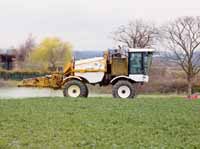Crop Watch: Catching up with herbicide applications

In Lincolnshire, Farmacy agronomist Philip Vickers was monitoring oilseed rape crops for cleavers, mayweed and thistles. “The window for applying clopyralid and picloram, which control these weeds, may only be a few days long, so we need to be prepared.”
Phoma and light leaf spot also needed to be watched, particularly where plants were small, and growers should be ready to apply a fungicide, he said.
Wheat bulb fly egg counts were high and badly affected fields should have already been treated with an egg hatch spray, he said. “Future herbicide applications on these fields will need careful timing to avoid crop damage from herbicides being applied too soon after chlorpyrifos.”
In Perthshire, many oilseed rape crops missed their light leaf spot spray in the autumn, so needed treating soon, said AICC agronomist Hamish Coutts.
“I’m treating the next few weeks as autumn and sprays applied in this period will be followed up by the normal spring stem extension application. As most oilseed rape crops are unlikely to require growth regulation, prothioconazole will be the fungicide active ingredient of choice.”
Foliar disease levels in winter barley and wheat were low, but crops would need constant monitoring in the run-up to the T0 spray timing, he said.
Neil Donkin, a Countrywide Farmers agronomist in Gloucestershire said beans and barley would be drilled as soon as possible and both crops would need pre-emergence herbicides for grass and broad-leaved weeds.
Cereal crops had developed well, but barley would need to be treated for rhynchosporium and net blotch, and septoria would need monitoring in wheat. However, it was still too early to treat these diseases, he noted.
Some oilseed rape crops had high phoma infection levels, particularly varieties with low resistance, he said. “Reports suggest light leaf spot is beginning to develop, so an early fungicide application is advisable and should be applied as soon as possible. There is no need for any growth regulation at this stage, so a flusilazole product would be the preferred option.”
In Cambridgeshire, some spring barley and bean drilling had been completed, thanks to a spell of reasonable weather, as well as some Atlantis and Pacifica (iodosulfuron + mesosulfuron) sprays, said UAP agronomist Will Foss.
Soils had warmed enough to start nitrogen mineralisation in soils and his first SMN results indicated levels were about average. “Further results are due this week and will be used to build a more comprehensive picture of SMN levels. Top dressing on oilseed rape started last week and will continue this week, before moving on to barley and second wheats.”
All first dressings would include nitrogen and sulphur, he said.
Click here to read the full reports

